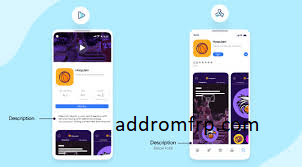How to Write an Effective App Description That Converts – Case Study: Instagram
Introduction

Ever puzzled why a few apps fly off the cabinets — or instead, get downloaded millions of times — whilst others slightly get noticed? One massive secret lies in their app description. This little block of textual content may seem minor. However, it’s a powerhouse for driving installs. Today, we’ll dive deep into how you may write a powerful app description that converts the usage of Instagram — one of the world’s most popular apps — as our case observes. Plus, I’ll share how Addromfrp permits you to craft descriptions that get real effects.
Understanding the Role of an App Description
An app description is more than just a list of features or an informal introduction. It’s your app’s first impression and a critical conversion device. Users often skim the description before identifying whether or not to download, and app stores use it to rank your app in search outcomes. That approach, a killer app description, hit the birds with one stone: convincing users and boosting visibility through ASO (App Store Optimization).
Key Elements of an Effective App Description
What makes an app description powerful? Let’s damage it down:
Clear and concise headline: Grab interest right now.
Features vs. Advantages: Don’t simply list what your app can do—tell customers how it makes their lives less complicated or better.
Strategic key phrases: Sprinkle them obviously to assist your app in getting located.
Social proof: Show off scores, critiques, or media mentions.
Instagram’s App Description Breakdown
Instagram nails its app description with a balance of clarity, emotion, and search engine optimization savvy. The headline hooks users by promising a manner to capture and share moments. Then, the description highlights key functions like Stories, Reels, and direct messaging, but continually in a manner that focuses on what the user gains — fun, connection, and creativity.
They additionally use emotional triggers: “Share your story,” “Stay related,” and “Explore the world” to create a feeling of belonging and exhilaration. The description is smooth, clean to experiment, and consists of the proper keywords without sounding spammy.
Instagram’s Use of Keywords and SEO Techniques
Instagram’s description is filled with clever keyword placements like “picture,” “video,” “testimonies,” and “messaging.” These aren’t simply random; they’re cautiously decided based on the capability users are attempting to find. Plus, Instagram localizes its descriptions for unique nations, ensuring they resonate globally.
Writing Your App Description: Step-by-Step Guide
Ready to write down your very own knockout app description? Follow the steps:
Step 1: Research your target market. Know their ache factors, goals, and language.
Step 2: Identify your app’s unique promoting points (USPs). What sets you apart?
Step 3: Craft a compelling headline. Make it catchy and advantage-pushed.
Step 4: Write feature-rich, advantage-driven content material. Users want to know, “What’s in it for me?”
Step 5: Incorporate applicable keywords. Don’t force it — hold it smooth.
Step 6: Use social proof and a sturdy call-to-motion (CTA). Invite users to download now.
Step 7: Optimize formatting. Use quick paragraphs, bullet points, and easy-to-read language.
Tips to Make Your Description Stand Out
Think of your app description as a communication. Talk to your consumers; you are no longer at them. Avoid technical jargon and keep matters easy. Storytelling can help paint an image of ways your app suits their lifestyles. And don’t forget to test extraordinary versions to peer what clicks.
Common Mistakes to Avoid in App Descriptions
Watch out for those pitfalls:
Keyword stuffing: Overloading your textual content with keywords will turn customers off and harm your ranking.
Listing simplest functions: Benefits remember more.
Ignoring updates: Always hold your description clean with new capabilities or enhancements.
Breaking save hints: Your description should comply with app shop policies to avoid rejection.
Tools and Resources for Crafting Effective App Descriptions
Use tools like Google Keyword Planner, App Annie, or Sensor Tower for keyword studies and competitor insights. For writing assistance, tools like Grammarly or Hemingway Editor keep your reproduction clean and punchy.
Measuring Success: How to Track Your Description’s Performance
Monitor your app shop analytics to display installation fees and consumer engagement. A/B testing exceptional descriptions can display what resonates first-rate. And concentrate on consumer feedback — it’s gold for tweaking your messaging.
Case Study Summary: Key Takeaways from Instagram
Instagram’s achievement boils down to three easy but effective methods: that specialize in blessings, emotional connection, clean structure, and clever keyword use. Adapting these ideas to your app can skyrocket your conversion costs.
How Addromfrp Can Help You Optimize Your App Descriptions
At Addromfrp, we specialize in crafting app descriptions that convert. Whether launching a new app or refreshing a present one, our crew dives deep into your audience, unearths your USPs, and writes descriptions that get clicks and installs. Let us help you turn browsers into unswerving users.
Conclusion
Writing a powerful app description isn’t rocket technological know-how — but it does require approach, empathy, and a bit of search engine optimization information. Take suggestions from Instagram’s approach: make it clean, consumer-focused, and keyword-smart. Keep trying out and improving, and watch your app downloads climb. And remember, Addromfrp is right here to guide you every step of the way.
FAQs
1. How lengthy should an app description be?
Aim for one hundred fifty-four hundred words to cover key factors without overwhelming the reader.
2. Can I replace my app description after publishing?
Absolutely! Regular updates hold your description fresh and reflect new functions.
3. What’s the distinction between features and blessings in a description?
Features are what your app does; benefits explain how it allows the user.
4. How frequently should I optimize my app description?
Review each 2-3 months or when liberating main updates.
5. Are keywords essential in app descriptions?
Yes, keywords improve your app’s visibility in keeping searches, but use them.
